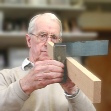

Sharpening with the aid of abrasive papers (Scary Sharpening) is an old technique, made more popular by the availability of better papers. While it has advantages for some workers, others prefer more durable whetstones. However (unlike water stones) they do have the disadvantage of being difficult to flatten.
To work effectively an oilstone has to wear away. Abrasives depend on individual grains fracturing and presenting fresh sharp faces to the metal. If this does not happen, an oilstone or grinding wheel will 'glaze' and lose some cutting power. As it breaks down, an oilstone is bound to become slightly hollow in length and probably across the width as well.
At a price, much harder diamond plates and synthetic sapphire ceramic alternatives are now available.If starting from scratch, the new technology might appeal, but a few minutes work every now and then can help you get the best from the traditional stones you may already own.
Natural stones, such as Arkansas and Charnley Forest stones are easiest to deal with, but first let us look at the modern ceramic bonded stones such as aluminium oxide, 'Aloxite' stones.
Sand and water on flagstones has been a popular traditional approach to flattening, but with modern abrasives, a better job can be done on a sheet of glass. Ordinary window glass, about 380 x 380 mm (15 x 15 inches) supported by a sheet of flat MDF or chipboard will serve. If you stick it down, use about nine blobs of a squidgy and flexible adhesive such as Black Bostik.
Instead of sand, use loose abrasive grains, between 40 and 80 grit, either of aluminium oxide or silicon carbide. Finding suppliers of small quantities of abrasive grits is not easy. It might mean buying more than necessary and paying postal charges as well. If you do need a considerable quantity, try a supplier of lapidary materials. Alternatively see below for a DIY source.
Motor valve grinding paste is a source of 80 grit silicon carbide grains. Use paraffin to thin the grease in which it is bound. (The fine abrasive in the other end of the tin can serve for dressing the coarser side of a leather strop). I'm informed, however that in some American valve-grinding pastes the binding material is water-soluble.
To control the dispersion of the grit, first put a few drops of paraffin on the plate, then sprinkle with a few taps of the finger. Do not use too much paraffin; the sludge washes off the plate. Work the oilstone in all directions, using all the surface of the glass. As the grains are crushed, the change in sound indicates when to re-charge with fresh grit.
Be careful when handling grits, it is amazing where they can get to. If some finds its way, for example onto a handkerchief used for cleaning spectacles, very expensive damage could result. Also protect the bench top with newspaper or grains will become transferred onto the surface of the next job and perhaps scratch the sole of your plane, to say nothing of blunting the edge. When the job is finished, it is easier to clean-up when the grinding sludge has dried.
Natural stones are usually easier to flatten. Use Aluminium Oxide coated abrasive sheets stuck to glass plate. 3M 'Spraymount', although expensive to buy just for this job, is ideal since it is designed to be easily strippable.
Spraymount Suppliers of artists materials
Valve grinding paste Motor accessory shops.
Grits are fixed to paper with two coats of glue,either soluble animal (hide) glues or insoluble resin glues. It is quite easy to extract grains from the hide-on-hide papers. Resin on hide is less satisfactory and resin on resin is hopeless for this dodge.
The best way to test what you have in stock is to try boiling water on a sample. If the grains easily detach as a mobile mud, you have the right kind of paper. Some enlightened suppliers actually detail the bond for each of their various papers. You should get more grit per sheet if you use close-coated paper. For me, a DIY store pack containing l0 x 1/3rd sheet size orbital sander sheets of extra-coarse, ie 40 grit, Aluminium Oxide costing 99p, yielded about 100 grams-- quite enough for trueing more than one oilstone in moderate condition.
Since the grains will not have become completely worn, I guess that old papers should serve fairly well for the job. A use for old paper at last!
If working in the kitchen, use newspaper to protect working surfaces from the abrasive grains.
The extraction is best done in an unwanted baking tray. Pour boillng water over the paper, one sheet at a time. With an old brush sweep the grains from the surface towards one corner of the tray. Use the opposite corner to pour away the water. Only a small amount of drossand dust should run away with the water.
Repeat with another sheet and fresh boiling water. Harvest your grains by brushing tleem into a shallow jam jar. Repeatedly rinse the glue away with several changes of boiling water. Continue until the water becomes clear and no longer feels sticky.
Decant the grains onto a plastic tray such as used for ready-meals. Put this in a warm place to dry. If in a hurry, cover thea tray (but not with a melamine laminate) and use a micro-wave oven set at 'De-frost'. The powder will be dry when, if loosened with a finger, it readily pours off the tray.
Store in the kind of plastic pot in which peppers are sold. A strip of sellotape across the holes will serve as a seal until the grains are needed.